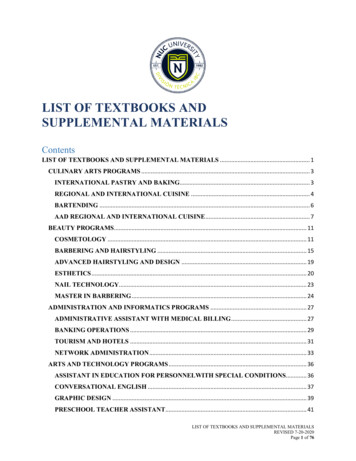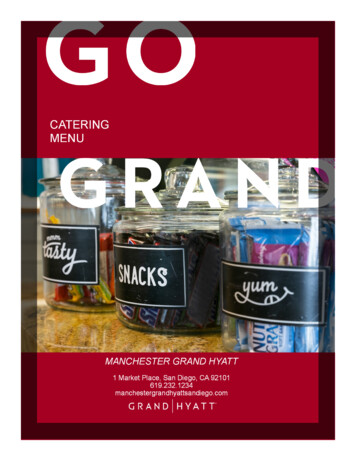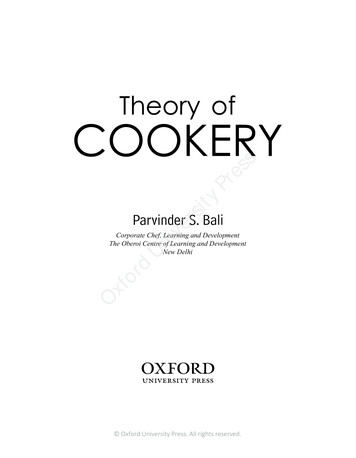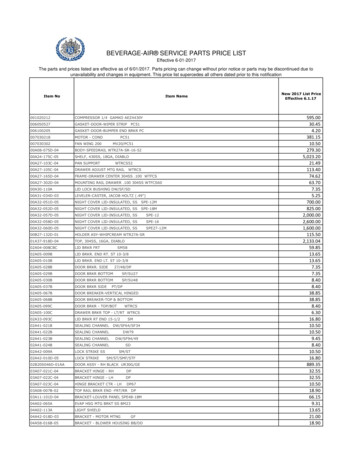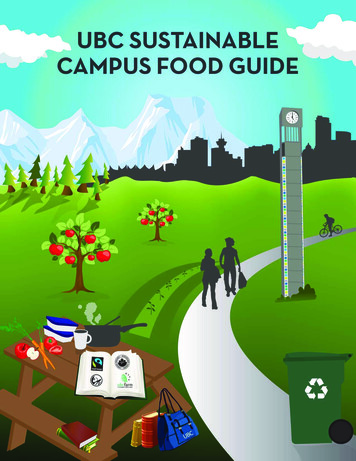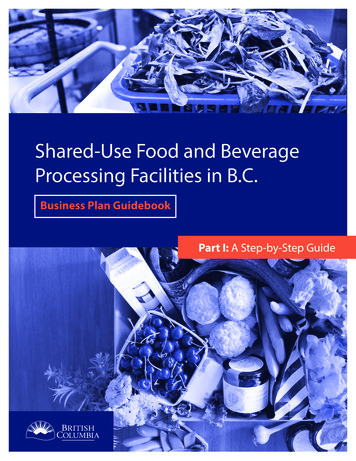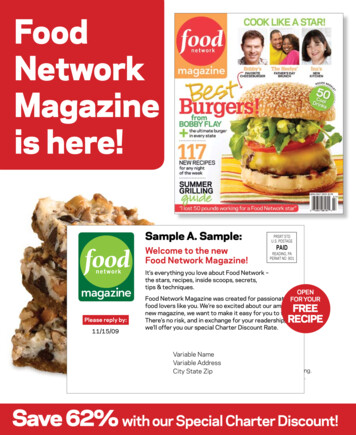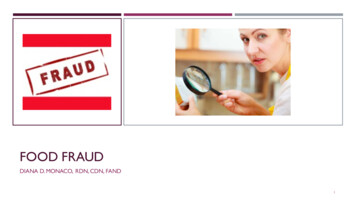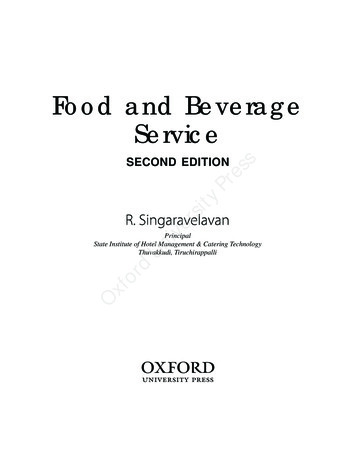
Transcription
Food and BeverageServiceUniversityPressSECOND EDITIONOxfordPrincipalState Institute of Hotel Management & Catering TechnologyThuvakkudi, Tiruchirappalli Oxford University Press. All rights reserved.Food and Beverage FM.indd 120/05/16 10:24 AM
3Oxford University Press is a department of the University of Oxford.It furthers the University’s objective of excellence in research, scholarship,and education by publishing worldwide. Oxford is a registered trade mark ofOxford University Press in the UK and in certain other countries.Published in India byOxford University PressYMCA Library Building, 1 Jai Singh Road, New Delhi 110001, India Oxford University Press 2011, 2016The moral rights of the author/s have been asserted.First edition published in 2011Second edition published in 2016ersityPressAll rights reserved. No part of this publication may be reproduced, stored ina retrieval system, or transmitted, in any form or by any means, without theprior permission in writing of Oxford University Press, or as expressly permittedby law, by licence, or under terms agreed with the appropriate reprographicsrights organization. Enquiries concerning reproduction outside the scope of theabove should be sent to the Rights Department, Oxford University Press, at theaddress above.You must not circulate this work in any other formand you must impose this same condition on any acquirer.UnivISBN-13: 978-0-19-946468-5ISBN-10: 0-19-946468-5Typeset in GaramondPro-Regularby Ideal Publishing Solutions, DelhiPrinted in India by Magic International (P) Ltd., Greater NoidadCover image: Yeko Photo Studio / ShutterstockOxforThird-party website addresses mentioned in this book are providedby Oxford University Press in good faith and for information only.Oxford University Press disclaims any responsibility for the material contained therein. Oxford University Press. All rights reserved.Food and Beverage FM.indd 220/05/16 10:24 AM
PREFACE TO THESECOND EDITIONUniversityPressOver the years, the lifestyle of people has changed resulting in an increased number of commercialfood service outlets, contract catering, institutional catering, transport catering, food retails,and hotels. All these establishments are in need of well informed and thoroughly trained foodservice professionals to extend quality services to their guests. In today’s competitive businessenvironment, quality of services makes a huge difference and remains a USP factor.It is heartening to note that the first edition of the book has been well-received by facultymembers, students, and practising managers. Hence, the second edition of the title Food andBeverage Service has been extensively revised and updated keeping in view the feedback received,the National Council for Hotel Management and Catering Technology syllabi, as well as theever-dynamic hospitality industry. Therefore, the text includes new chapters on menu knowledge;costs, sales, and profit; and food cost controls. Sections on pairing wine with Asian food, andEU regulations and labelling laws have also been covered keeping in mind the needs of not onlystudents, but practitioners.NEW TO THIS EDITIONord New chapters on Menu Knowledge; Costs, Sales, and Profit; and Food Cost Control New sections on EU wine regulations and labelling laws, and pairing wine with Asian food Augmented web resources for both teachers and studentsOxfCONTENTS AND COVERAGEThe book has 51 chapters that have been divided into six parts.Part I: Introduction to Food and Beverage ServiceChapter 1 provides an introduction to the food service industry in India, along with the employmentopportunities it provides.Chapter 2 discusses the various functions of food and beverage staff of hotel, and the intra- andinter-department relationships.Different types of food service equipment as well as ways to properly store them have beenmentioned in Chapter 3.Chapter 4 explains the functions of various ancillary sections such as still room, silver room,linen store, etc.The various styles of food service—waiter service, self-service, and assisted service—have beendiscussed in Chapter 5.Part II: Menu Knowledge and PlanningThe origin and types of menu are explained in Chapter 6. Oxford University Press. All rights reserved.Food and Beverage FM.indd 520/05/16 10:24 AM
Chapter 7 gives detailed knowledge about compound butters, sauces, and the French classical course.Chapter 8 discusses the cover and accompaniments for selected Continental and Indian dishes.Chapter 9 explains the various French and culinary terms used in F&B service.The process of planning various types of menus have been dealt with in Chapter 10.Part III: Food ServiceressChapter 11 discusses the activities to be carried out before and after the service, whereas Chapter 12explains the service procedure for à la carte lunch or dinner and table d’hôte menu.Chapters 13 and 14 elaborate on the types of menus, covers, and service procedures associatedwith breakfast, and brunch and afternoon tea, respectively.The entire process of room service, from location and equipment required to taking orders andexecution to in-room facilities, have been dealt with in Chapter 15.Chapter 16 explains guéridon service, including the types of trolley, equipment used, foodpreparation techniques, and dishes prepared on the trolley.Order taking and billing methods are discussed in Chapter 17.Chapter 18 focuses on handling different situations and guests in the dining areas.ordUniversitChapter 19 discusses various non-alcoholic beverages such as coffee, tea, milk-based drinks, juices, etc.,whereas Chapter 20 deals with alcoholic beverages, their classification, and methods of preparation.Chapter 21 provides an introduction to wine, its classification, characteristics, factors thatinfluence its character, and grape varieties used. The process of winemaking—still and sparkling—is covered in Chapter 22. Chapters 23 and 24 deal with fortified wines such as Sherry and Madeira,and vermouth and bitters, respectively.Wines of France, their classification, regions, and laws have been included in Chapter 25.Wines of Italy, Germany, Spain, and Portugal are discussed in Chapters 26, 27, and 28. Chapter29 focuses on the wines of various other countries such as the USA, Australia, South Africa,Hungary, and India. Chapter 30 explains the rules for pairing wine with food and problem dishes.The special focus is on pairing Asian food with the right wine.Chapter 31 deals with beer, its production, strength, and storage. Major spirits such as cider,perry, whisky, brandy, gin, rum, vodka, tequila, and mescal are covered in Chapters 32–39.Liqueurs and eaux-de-vie are explained in Chapter 40.The service of alcoholic beverages, such as wines, beer, spirits, liqueurs, and cocktails arediscussed in Chapter 41. Chapter 42 provides information about components of cocktails, themethods, equipment, and glassware used, and rules to follow when making cocktails and mixeddrinks. This chapter also discusses hot drinks and mocktails.Chapter 43 elaborates on cigar, its structure, brands, and service. Service of cigarettes is alsoincluded in this chapter.OxfPreface to the Second EditionviyPPart IV: Beverages and TobaccoPart V: Bar Operations and ControlChapter 44 discusses the function of cellar, location, and storage, as well as cellar control and records.Bar operations, such as types of bars, their design, records and control, and operationsprocedures have been dealt with in Chapter 45.Part VI: Ancillary FunctionsChapter 46 covers topics such as types of function, duties, and responsibilities of function staff,table arrangements, function menus, buffet set-up, and service procedure for formal functions. Oxford University Press. All rights reserved.Food and Beverage FM.indd 620/05/16 10:24 AM
Supervisory functions in food service operations, such as briefing, allocation of tables, stocktaking, and cost analysis, are discussed in Chapter 47.Chapter 48 explains the different types of costs involved in food and beverage service operations,whereas the process of monitoring and regulating the food cost is covered in Chapter 49.Chapter 50 discusses the importance of customer relations management in F&B service industry.Chapter 51 provides information about the safety measures to be taken while handling andstoring food products.ONLINE RESOURCESThe following resources are available to support the faculty and students using this text.For Students PowerPoint presentations Multiple-choice questions Flashcard glossaryressFor FacultyyPACKNOWLEDGEMENTSersitUnivdorOxfviiPreface to the Second EditionI would like to express sincere gratitude to many of my friends and colleagues from the hospitalityindustry and the academia who assisted me in many ways in the writing of this book. ThoughI would like to name them all, it is practically not possible to do so. I would particularly like tothank the following persons:Mr Keerthivasan, General Manager, Ambasador Pallava, ChennaiMr K. Venkataraju, Executive Assistant Manager, Hotel Ambassador Pallava, ChennaiMr S.A. Balraja, Principal, Sterling Holiday Resorts, KodaikanalMr Subramanian, General Manager, Heritage Inn, CoimbatoreMr K. Ramachandran, General Manager, Heritage Inn, CoimbatoreMr Sonu Koithara, Executive Chef, Taj Kovalam, Kovalam, TrivandrumMr Ashok, Executive Chef, The Residency, CoimbatoreMr Samuel David, Chief Engineer, Taj Kovalam, Kovalam, TrivandrumMr D.A. Santhavadanam, Executive House Keeper, Hotel Savera, ChennaiMr P.R. Babu Varma, Senior Manager—Projects (Food Services), Sodexo Food, Facilities andProject ManagementI also thank my teacher and mentor Mr A. Jeyachandran, Corporate Training Consultant atTaj Hotel, for his continuous encouragement and support.I express my gratitude to the Managing Trustee and Trustees of SNR Sons Charitable Trustand the Principal for their motivation. I thank my colleagues and students for their assistance.My thanks are due to the editorial team at Oxford University Press India for their valuabletime, constant support, and encouragement to complete this book.I owe a lot to my parents—Late Mr C.S. Ramalingam and Mrs Vijayalakshmi Ramalingam—for making me what I am today. I thank my wife, S. Pushpalatha, for being patient and puttingup with my late night work and also my daughter, S. Vijayalaxmi, for drawing some pictures forthe book.Every effort has been made to determine and contact copyright holders. In case of any omissions,the publisher will be pleased to make suitable acknowledgment in future editions.Suggestions and feedback are welcome and can be sent to me at svelavan.singaravelavan@gmail.com.R. SINGARAVELAVAN Oxford University Press. All rights reserved.Food and Beverage FM.indd 720/05/16 10:24 AM
PREFACE TO THEFIRST EDITIONOxfordUniversityPressThe food service industry is witnessing a tremendous growth all over the globe, especially in Indiawith the second largest population in the world. The present-day generation depends largely onthe food service operators while on the move, at workplace, and when away from home for variousreasons. The rise in disposable income, the 24 7 work culture, changing lifestyle, lack of time andenthusiasm to cook after a long day’s work, and many other factors make people have food outsidetheir homes. Eating out is no more a luxury today; in fact it is a necessity for most people. Thishas resulted in a steady growth in the food service sector. As a result, today this sector is home toexcellent job opportunities, directly and indirectly.Food and beverage (F&B) service is one of the vital operations in the accommodation sectorand the key area in non-residential catering sector. These sectors are constantly in need of welltrained staff to deliver the services for satisfying their customers. Hotel management institutionsall around the world work towards training students to produce quality manpower to serve theindustry.The F&B sector requires highly motivated individuals. Working in this sector involves soundunderstanding of basic concepts of food service, as well as a lot of practical insight into theintricacies of diverse service procedures. Aspiring professionals in this field must be prepared todeal with demanding schedules and short deadlines, and in doing that, extend the best hospitalityto their guests.Food and beverage service is one of the most important subjects in degree and diploma coursesin hotel management and catering technology and a core subject in craftsmanship course in F&Bservice. There are very few books on this subject and most of them are highly priced. Besides, mostbooks do not provide a proper coverage of the hotel management syllabi in India. The need fordesigning the most comprehensive textbook covering all the topics of F&B service prescribed inthe syllabi of the National Council for Hotel Management, technical boards, and universities atan affordable price prompted me to write this book. My 30 years of experience in teaching andtraining students in F&B service has been of immense help in understanding the areas where thehotel management students normally have more doubts, and what their requirements are. Writtenin a simple language, this book can be easily understood by all students.This book will also be of immense help to the entrepreneurs who want to start a food servicebusiness of their own, as also to the professionals and the trainers in the industry.ABOUT THE BOOKThe book introduces the students to the various aspects of F&B service. It begins with a discussionon the evolving F&B industry and service procedures, including organization of the staff membersand service equipment that form an important part of the F&B department. Oxford University Press. All rights reserved.Food and Beverage FM.indd 820/05/16 10:24 AM
dorOxfR. SINGARAVELAVANixPreface to the First EditionUniversityPressThe book lays emphasis on the importance of knowing and planning the menu well. Thestudents will also learn about various kinds of covers and courses. In the rapidly evolving world ofF&B service, it is necessary to keep oneself updated with the active terminology of the industry.The book addresses this area by including a comprehensive set of French and culinary terms.Readers will also be made familiar with different types of food services, such as room service,guéridon service, order taking etc., along with their unique requirements. The book presents acomprehensive discussion on the various kinds of alcoholic drinks (wine, spirits, beer, etc.) andnon-alcoholic drinks (tea, coffee, aerated drinks, etc.). It enumerates the distinct constitution andmanufacturing processes of the drinks, along with their service procedures, in detail. It particularlyelaborates on the most popular wine labels from different regions of the world.While enumerating various alcoholic beverages, the book also takes into account the appropriatemethods to store them and monitor their sales, along with the different ways in which they areserved at bars. The discussion on cellar and bar operations helps students understand the practicalprocesses and guidelines involved in beverage services, as they take place in the industry.Apart from the aforementioned topics that comprise the core of F&B service, the book alsodelves into some important ancillary functions in order to help students gain a holistic perspectiveto F&B services in particular, and the industry at large. With attention to issues such as customerrelationship management (CRM) and environmental concerns, the book positions its relevance inthe contemporary world of F&B service. Oxford University Press. All rights reserved.Food and Beverage FM.indd 920/05/16 10:24 AM
FEATURES OFGarnishMany drinks have standardized garnishes. These are a part of the product. The names of someof the cocktails are changed according to the garnish. For example, if you garnish martini withpearl onion instead of olive, it becomes Gibson. Olive, cherry, orange, spirals of orange and lemonObjectivespeels, lemon wheels,Learninglemon wedges,pearl onions, etc., are the commonly used garnishes. Basically,outlineof themainconceptsandcocktails are garnished withcocktails are either Answeetor dry andacidic.In general,all sweetcherries and dry cocktailsgarnished whatwith olivelemonexpectslices. toideasareindicatesyouor canIt should be remembered that some drinks do not have any standard garnish and it is advisableEnglishBreakfastCoverfromeachchapterto serve without anylearngarnish,insteadof tryingout different garnishes and spoiling the real flavourand value of the drink. The items required to lay the English9FRENCH ANDCULINARY TERMSUnivknifefacing left-hand sidebeer manufacturing.GrenadinePomegranateRedService of Mineral Wate561Most guests prefer mineraltap water. Mineral watersat temperature range of 7–1addition of ice unless requcan be served in Paris goslim Jim glass. Mineral wmixed with alcoholic drinkCocktails and MocktailsersityPressbreakfast cover (refer to Fig. 13.4 andMETHODS OF MAKING COCKTAILSTable 13.2) are as follows: oneSideplatewith sideknife in this section according to the type ofCocktailsaremadeinanyof themethodsdiscussedLEARNING OBJECTIVESFRENCH AND CULINARYTERMS Fish knife and forkAfter reading this chapter, you will modifier ingredients in use.Catering professionalsand studentsmustforkhave sound knowledge of Largeknife andbe able tothe culinary and French terms that are very often found on menu understand the oft-usedBuildingculinary Dessert spoon and forkcards and culinary books. Culinary terms are Tankdifferent from FrenchtermsMill FrenchBreakfastcupone andsaucerwithand as someterms,terms,cannotIt is madetermsby pouringthe ingredientsoneespeciallybyinculinarytheglassin whichit isbeto be servedthenisBeer,wheretheconsumptionlevel isandtooishigh, write French names of yare.inSwizzlebulk quantityby roadetc.,tankers.Thesestirred. Iceis addedto ifEnglish,the recipeforbeit.writtenHighballs,Rickey,, hot drinks,are madeingredients and identify theirBoilingwaterIn rstanddeliverthe beertheservingcellar ofglass.the vendor’s ingredientsNapkinby this methodwherein cateringtheare addedonetankersoneintototheIf icegenderthe itFrenchtermsin beforeorderexplaintheingredients.dishesplaceto guestseffectively.A beer is directed to largeandrequiredfromthere the write the menu in Frenchis required,is ntanks.Thealsocapacityof tank is normally 90 or 180workingknowledge of French grammar and menutermsfacilitatesSpentTable 19.7 Names of syrups with their flavour and colourareasfollows:compiling the menu. There are many typicalgallons.terms used which callFigure 13.4 English breakfast cover with wateringlass31.1 Flavourshowsfollowed in theStirringName Figurefor a separate bookto explainthis topic. However,the followingarethe steps ColourHops, sugarandRibeiro Earlier, it produced heavy somewhiteculinarywinesandfromthepalominogrape,that tendedto beproductionof ixingoxidized. The cooperatives in this area recently startedencouraging the plantingnative2 hoursCitron and usingLemonYellowof the ingredientswith ice,: byinà laIn stirringthe grapes.stylequicklyof. Forexample,à la française,meansIllustrationsgrapes—torrontés and herryRedS. no.Itemstreixadura andPositionTERMSUSEDINBEERMANUFACTURINGa mixing glass with the andàl’anglaise,Spent twograpeglass.varieties.Thisgiveslightand totheappropriateDrinksmadeupofremoved1.Side plate with side Left-hand side of the cover, side knife over the underplate with cuttingedge are some important terms related toThefollowingGommeSugar ňaCosteiraarenotedwinesofthisarea.figures and formats; examples,à la suchbrocheas spirits,: liqueurs,Roasted onwines,a spit andclear liquids254La Manchaord12345Water- and so: oneffervescentare alwaysà la drinks,crèmeLightlycoatedstirred.with cream winesSyrupstables,2.andpicturesalso providedRiasBaixas areIt romalbariñoNapkinOn theside plate,underthe sideknife or in thecentre of whitethe coverOrgeatColourless insolubleReceiverMalting ItFigureis Almondthe processof converting42.1 StirringIt is doneà veryquickly to minimizethe dilution.la diable: Highly seasoneddishSyrups are inthecerealtosolublesugar.in the3.text forbettercupcomprehensionBreakfastandTo the right-handAiguilletteside of the cover, :handleof thecupthe right,slightlyLong thinsliceof towardscooked meatcutfromthe Theybreastare used in the preparation of cocktails, milk shakes, and ienceinhandling,by the reader al denteGristItstagerefersto e19.7 lists the commonly found syru: Termused for cooking gteaspoon on the saucer with handles towardsrightstill retainsfirmness of biteMashIt refers to hot water and grist.Fish knife and forkFood and Beverage ServiceFood and Beverage ServiceOxfServicegratin: ofDishsprinkledwithbreadcrumbsand gratedIt isrighttheAumixingingredients(seetheKnife to theandfork tooftheleftthe thoroughlycover(outsidecover)Fermenting tankWort-yeastWortPreparedIt refersto areboiledwith maltCollins.and The straw holder is placeddrinksservedwaterin ingtheminacocktailis theknifelargest,qualityareatoinis nativeaircover)énhop., the widelyplanted(Yeast5. ThisLargeand forkKnifewine-producingto the right and forktheEurope.leftof added)theItcover(insidetotheAmuses-bouches: theAssortedcocktailcanapésandMostsmall withlowacidity.thewines4866.Dessert spoon and Top of thecover, dessertthetop withtowardsright and theCONCLUSIONBlanquette: Whitestewhandlecookedin stockShakingis used spoonwhen oningredientssuchas cream,SpargingIt refers to spraying hot water toare distilledto spirits andinwithblending.forkforkuseddownspoonhandleleft otherssugarrefersfromtotheAubleuMethodof towardssyrup: amongare used freshextractThemaximumterm ‘beverage’all malt.types of potable drinks, except water. People pretrout ina courtneverbouillongivesa bluewithtingein the recipe. Effervescent drinksshouldbe whichof drinks,after meals.BeveragesPitchingIt refersmeals,to theandadditionof yeastto the are classified into two main gValdepeñas(NOTE:All-purpose breakfast cover is laid as for e: Boned and stuffed leg of poultryshaken.wortandfor non-alcoholicfermentation.drinks. A license is required to sell alcoholic beverages and theCask conditionedBottlesKegBulk storageto stopto a person who is drunk and intoxicatedBaron The chief: redDoublesirloinwith isthecencibelrumps rightof(localbeefasnamea servingwholeThis area is known for its fruity red wines.grapevarietyforalcoholic erstothe solutionof sugar andjoint; 31.1Productionof odtheserviceorganization serves one or more types of beverages to satisfy guRememberhops toEverydevelopbeer.as one whole jointBlending Budandofmenusincludenames of beverages on offer. On an average, sale of non-afrom airén grapeand vasethe deep ruby colour is obtained from the additioncencibelandBaked beans inproducedtomato sauce,Beurre manié: Equal quantities of butter andflourkneadedFiningItrefersto the processof brighteningamountstoapproximately35–40%ofthe drinktotaltherevenue in popular and fast food Preservesdish onis anunderlinerwithfruits,preservesThis methodusedfor combiningsolid spoonfoods, ice, etc.,in an electric blender.Anygrapes.sausages, bacongarnacharashes, friedeggs,together. It is used as a thickeningagentbeer byTheaddingisinglassor awareseaweed.caterermust beof new beverages in the market as food Blendingisasuitablemethodformaking Sugarbowlwithsugarcubesand grilled mushroom are the mostintroducing new drinks to sustain themselves in the competition and to meet thFigure 31.2 shows a flow chart representationSidebarsof beers according toof consumers. Some examples are diet Cola, sports drink, energy drink, soya miValencia Cruet Table 31.2 Classificationpreferred breakfastmain dishes,of the entirebeermanufacturingprocess. for making tea, coffee, and milk-basealcoholiccontentThe stillroomof a hotel is responsibleplated together on a full plate.Important points appear as sidebars Table number4.It is noted for earthy and full-bodied rosé and red wines made from local bobalthegrapes.of aerated waters, minerals, squashes, and juices. However,dispenseMostbar servesFood and Beverage Service444 The AmericansFoodpreferBeverage Ch09.inddcoffee, while and1717:39 PMMost hotelslay an all-purposecoverbreakfastthroughoutthetext for Englishquickreferencethereis no bar, the21/04/16still roomsupplies those drinks.TermAlcohol breakfastrange (%by volume)Beverage Ch42.indd561 techniques.25/04/16the andproducers Fooduse coolfermentationSTRENGTH OF BEERthe British prefer tea during thebreakfast.which includesall the itemsAlcohol-freeNotmentionedmore than 0.5%for English breakfast cover,KEYTheTERMSaverage strength of beer is approximately fourexcept fishLowknifeand fork. 0.5–1.2%alcoholAlicante5:26 PMAlkaloidIt refers tobutalkalinecompoundfoundIt is an aromatic perenniper centby volume,thereare beerswith CamomilletheIndian3–4%in plants.Flor (Spanish and Portuguese Standardpercentageof 10 per cent, often termedEurope and Asia with delicate leavesMonastrell grapeis used for making red alcoholicandAmarettoroséwines.Therefers wine.to almondapricotPremium4–6%Breakfastfor flower) is a winemaking termas strongale orIt barleyTheseandstrongbeersCoffeeare grind It refers to a texture of avour liqueur.Coffee substitute It is a drink madeStrong6–8%referring to a film of yeast on theavailablein bottlesizesof about 180ml.cereal without coffee powder.BeakerItisawide-mouthedcupwithoutaIndia isa land of varied culture, language, and varied eatingstuffedparathas,have habits.a good Parathas,ageing property.grapeThe Moscatelclassificationof beers according to Cognacthesurface of wine. It is important in the Super note, and they8–11%handle.it is a brandy from Cognac repoori manufacturemasala, 2.BrontëIt refersto honeyherbsCointreau It is an orange-flavoured liqcertain styles of sherry.Bénédictinebread and rolls and egg preparations. In southSalvadorIndia, dosa,idli, Bodegasvada, pongalupma, khichdi,liqueuretc.,with flavour of herbs and spicesProveda,Eval,arenotedredIt iswines.Caffeine it is a stimulant found in coffee, tea, and cocoaare served; not many south Indians take egg preparations during breakfast. To addresstheneedswhich stimulates the central nervous system.Montilla-MorilesFoodBeverage Ch13.inddFoodandandBeverage FM.inddThis region lies in the hillsnear Córdobaandproducesin the style of sherry.OxfordUniversityPress.flor-growingAll rightswinesreserved.Food and Beverage Ch31.indd486It is not usually fortified and it cannot be called sherry. The predominant grape used is the pedroFood and Beverage Ch19.indd 355ximare12:47 PM25422/04/1610 énez (PX). Around half the Montilla-Moriles wines are fortified, but the unfortified winesDecaffeinated Coffee It refers to coffeDrambuie it is a honey-flavoured liquKahlúa It is a coffee-flavoured liqueur23/04/16 6:00 PM20/05/16 10:24 AM
THE BOOKCONCLUSIONBrandy is distilled from grapes either by pot still of patent still depending on the style of brandybeing produced. Brandies assume such characteristics as body, colour, bouquet, etc. during ageingin the casks. Every wine-producing country makes brandy. Of all the brandies produced in theworld, Cognac is regarded as the best followed by Armagnac. Cognac and Armagnac are brandiesproduced in delimited areas of Cognac and Armagnac, France. Brandy distilled from any otherfruit is termed as fruit brandy and it is named after the fruit.Brandy is served at the end of the meal. Brandy is also used in the cocktail preparation.ressConclusionKEY TERMSA recapitulation of key ideas andmonitoringtheorproductionof Armagnac.Abv This is the short form for alcohol by volume.to cafeteriasfast food outletsduring lunch and breakfast time and to a fine-dinCONCLUSIONconcepts that are discussed in eachBlending It is the process of mixing drinks Maturation carveryIt is theprocessof allowingthe spirittoduringweekendsor for dinner.The expectationsof level of service by guebymembersoffamily,friends,business class customers will be different anto achieveconsistencyof the requiredrestbrandyin wooden cask and to take on the andcharacteristicssectiongivenfromfor grapeseasy retentionBrandy is isdistilledeither by potstill of thepatentstill dependingon the style ofsuccessful, the operator must understand this distinction and provide the serviceersityPbouquet, colour,body,colour,etc. in thefinal drink.fromageingthe wood and air that enters through fine poresbeing
Chapter 30 explains the rules for pairing wine with food and problem dishes. The special focus is on pairing Asian food with the right wine. Chapter 31 deals with beer, its production, strength, and storage. Major spirits such as cider, perry, whisky, brandy, gin, rum,
